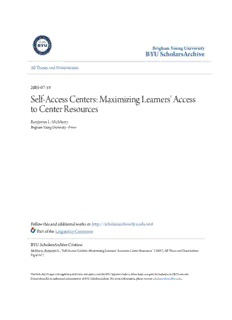Table Of ContentBBrriigghhaamm YYoouunngg UUnniivveerrssiittyy
BBYYUU SScchhoollaarrssAArrcchhiivvee
Theses and Dissertations
2005-07-19
SSeellff--AAcccceessss CCeenntteerrss:: MMaaxxiimmiizziinngg LLeeaarrnneerrss'' AAcccceessss ttoo CCeenntteerr
RReessoouurrcceess
Benjamin L. McMurry
Brigham Young University - Provo
Follow this and additional works at: https://scholarsarchive.byu.edu/etd
Part of the Linguistics Commons
BBYYUU SScchhoollaarrssAArrcchhiivvee CCiittaattiioonn
McMurry, Benjamin L., "Self-Access Centers: Maximizing Learners' Access to Center Resources" (2005).
Theses and Dissertations. 617.
https://scholarsarchive.byu.edu/etd/617
This Selected Project is brought to you for free and open access by BYU ScholarsArchive. It has been accepted for
inclusion in Theses and Dissertations by an authorized administrator of BYU ScholarsArchive. For more
information, please contact scholarsarchive@byu.edu, ellen_amatangelo@byu.edu.
ii
Self-Access Centers: Maximizing Learners’ Access to Center Resources
By
Benjamin L. McMurry
A master’s project submitted to the faculty of
Brigham Young University
In partial fulfillment of the requirements for the degree of
Master of Arts
Department of Linguistics and the English Language
Brigham Young University
August 2005
Copyright © 2005 Benjamin L. McMurry
All Rights Reserved
BRIGHAM YOUNG UNIVERSITY
GRADUATE COMMITTEE APPROVAL
Of a master’s project submitted by
Benjamin L. McMurry
This project has been read by each member of the following graduate committee and by a
majority vote has been found satisfactory.
_________________________________ ____________________________________
Date Mark W. Tanner (Chair)
_________________________________ ____________________________________
Date Neil J. Anderson
_________________________________ ____________________________________
Date Glen W. Probst
BRIGHAM YOUNG UNIVERSITY
As chair of this candidate’s graduate committee, I have read the project of Benjamin L.
McMurry in its final form and have found that (1) its format, citations, and
bibliographical style are consistent and acceptable and fulfill university and department
style requirements; (2) its illustrative materials including figures, tables, and charts are in
place; and (3) the final manuscript is satisfactory to the graduate committee and is ready
for submission to the university library.
_________________________________ ____________________________________
Date Mark W. Tanner
Chair, Graduate Committee
Accepted for the Department ____________________________________
Alan Manning
Graduate Coordinator
Accepted for the College ____________________________________
John Rosenberg
Dean, College of Humanities
ABSTRACT
Self-Access Centers: Maximizing Learners’ Access to Center Resources
Benjamin L. McMurry
Department of Linguistics and English Language
Master of Arts
The Self-Access Study Center (SASC) at Brigham Young University’s English
Language Center (ELC) is a self-access lab where students can work independently to
improve their language skills. Although some students have discovered how to use the
SASC effectively, the majority of them appear to be unaware of the resources available in
the center. Their trips to the SASC end up becoming more like a cyber cafe situation,
where friends send email and chat online. If the SASC is used merely as a computer lab,
then students are not using the resources available to fine-tune their English skills.
The current project addresses two points. First, in an effort to provide on-going
support for students and teachers, a Web site and database were created to provide users
with information regarding materials available in the SASC at Brigham Young
University’s English Language Center. Second, a SASC orientation for both students and
teachers at the ELC was implemented in September of 2004. It took place in the SASC
and gave students and teachers a brief explanation about how to use the SASC
effectively.
ELC students later completed a survey as means of gathering feedback regarding
the use of the SASC. The survey data showed that the students felt the website was very
helpful and that the orientation had a strong influence on how students used the SASC. A
analysis of the data showed that students tended to be more autonomous as a result of the
SASC Orientation. The results from the 2004 survey, with regards to the materials that
students reported using, indicate that students used the SASC more for individual use and
group work than to fulfill assignments or requirements from their teachers.
ACKNOWLEDGEMENTS
I would like to thank my committee for their work and support. I would also like to
recognize the staff, faculty and students at the ELC and thank them for helping me
accomplish my goals. Finally, none of this would have been possible without my sweet
wife. Thank you.
viii
TABLE OF CONTENTS
List of Tables...................................................................................................................X
List of Figures.................................................................................................................XI
Section 1: Introduction.....................................................................................................1
Section 2: Review of the Literature..................................................................................4
Defining Autonomy.......................................................................................................4
Promoting Autonomy....................................................................................................8
Using Self-Access centers to Promote Autonomy........................................................9
Self-Access..................................................................................................................12
Section 3: Rationale for the Project................................................................................15
Section 4 Project Design.................................................................................................17
Database/Web site.......................................................................................................17
Orientation...................................................................................................................22
Evaluation....................................................................................................................24
Section 5: Project Development.....................................................................................25
Database and Web site Construction...........................................................................25
Orientation Development............................................................................................26
Evaluation Development and Implementation............................................................26
Section 6: Results...........................................................................................................28
Feedback from students...............................................................................................28
Survey Demographics.................................................................................................29
Section 7: Conclusions, Implications and Suggestions..................................................35
Limitations..................................................................................................................37
Directions for Future Research...................................................................................38
ix
References......................................................................................................................41
Appendix A.....................................................................................................................43
Appendix B.....................................................................................................................49
Appendix C.....................................................................................................................61
Description:This Selected Project is brought to you for free and open access by BYU support for students and teachers, a Web site and database were created to provide .. self-access, teacher-led autonomy, and teach-yourself autonomy in the middle of the . self-access reaches deep into all areas of autonomy.

